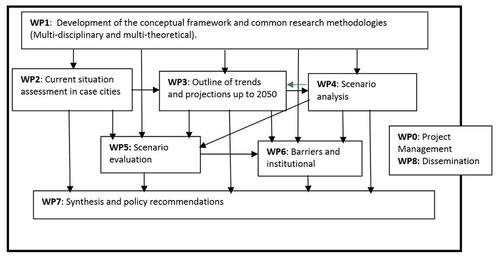|
Given the overall aim of the project, eight work packages (WPs) are identified. The following diagram shows the structure: |
 |
WP0: Project management
Task1: Organising the work, arranging project events, budgeting and accounting, reporting etc.
Task2: Identification of national and case cities’ stakeholders
WP1: Development of the conceptual framework and common methodologies
WP1 will provide a conceptual framework for the project for the analysis of how the inherent RUI to the climate problem affect decision-making strategies and institutional management. WP1 will also outline various methodologies for the assessment of the current situation and BAU scenario, scenario analysis approach and methodology for the evaluation of the social and economic impacts of a scenario.
Task1: Review of climate policies for the transport sector and the institutional arrangement and governance of the transport sector, in particular related to the three selected case cities and policy interventions used at the global level and in selected countries in Asia, and in India in particular.
Task2: Identification of policy instruments, with emphasis on new ones, with focus on case cities, the potential interactions of the policy instruments, and the ease of their implementations in India.
Task3: Development of theoretical frameworks, with focus on economic discipline, for addressing the design and evaluation of policy instruments with consideration to RUI
Task4: Identification and evaluation of the best methodologies, for assessing the current situation in India and in the case cities and the projection of the trends up to 2050.
Task5: Development of the scenario analysis approach and evaluation methodology.
WP1 provides a multi-disciplinary and multi-theoretical framework for the whole project.
Task1 and Task2 will be conducted with consultations with case cities’ stakeholders
WP2: Assessment of the current situation in each of the case cities
WP2 will contain an assessment of the current state in the case cities in terms of six aspects deemed relevant for transport-related climate change.
Task1: Demography and population growth situation; population segments and distribution.
Task2: Economy; economic development - national and local, GDP by sectors, distribution of wealth, household incomes, poverty levels etc.
Task3: Level of technological development (transport); transport infrastructure, alternative fuel vehicles, transport energy efficiency, warning systems, etc.
Task4: Mobility and motorisation; motorisation levels, non-motorised mobility, modal distribution, transport system capacity and coverage, etc.
Task5: Identification and assessment of the transport-related institutions in the case cities; public and private, and their internal organization, and any apparent barriers to adaptive strategy implementation.
Task6: Climate and the environment (base level); analysis of current climate data and pollution levels. The analysis will be based on an ensemble of recent empirical and regional downscaling data for Indian cities. The regional downscaling may be collected from the CORDEX project (http://wcrp-cordex.ipsl.jussieu.fr/). A present day emission scenario will be used to drive the EMEP chemical transport model in order to derive particulate matter (PM), and ozone concentrations and associated health effects in the 3 city areas.
WP3: The development of trends and climate change impact up to 2050
WP3 outlines the trends (of aspects named in WP2), and project the climate change impact in the case cities in 2050. The evaluation of the climate change impacts, by 2050, on the case cities under the BAU scenario in performed under WP3.
Task 1 through 6 will address the same respective issues as in WP2, but with focus on the situation in India up to 2050. Partners responsible for the respective tasks in WP3 are the same as the corresponding tasks in WP2. In addition, the following impact assessments will be performed:
Task 7: Climate change impact on the transport infrastructure.
Task 8: Social impact of climate change on various population groups, health and wellbeing effects, etc. In terms of health effects, the downscaled future climate scenario and the derived transport scenarios for the cities, combined with appropriate emission scenarios for India/Asia, will be used as basis for deriving health effects of ozone and PM (including climate change). The downscaled future climate scenario and the present day emission scenarios will be used to derive increases in health effects only due to climate change.
Task 9: Economic impact of climate change in the case cities, and for the population (e.g., household income, wealth distribution, poverty levels, etc.)
WP4: Scenario analysis
WP4 focuses on the application of the theoretical framework, developed under WP1, for the design and evaluation of the alternative scenarios for climate change mitigation and adaptation for the three area case cities. It also take on the identification of the interactions of the selected policy instruments for climate change mitigation and adaptation, and identification of complementary policies for improving efficiency and distributional outcomes. Identification of the implementation paths of policy packages will be performed under WP4. Furthermore, WP4 assesses the uncertainties associated with different scenarios in addition to the risk and uncertainties associated with goal achievements related to climate change mitigation and adaptation in the case cities under alternative scenarios. A scenario analysis approach will be utilised in WP4.
Task1: Development of scenarios through identification of policy packages and their implementation path.
Task2: Interaction between strategies for reducing climate change and strategies for adapting to climate change.
Task2: Consultations with stakeholders on alternative scenarios.
Task3: Selection of scenario(s) for evaluation.
WP5: Evaluation of the mitigation/adaption scenarios
WP5 will further adjust the evaluation methodology developed under WP1 for the evaluation of the social and economic as well as distributional impacts under scenarios analysed in WP4. WP5 will also address the potentials for GHG reduction and society’s resilience to climate change and the effectiveness of the suggested policy packages for climate change mitigation and adaptation goal achievements. Furthermore, WP5 attempts to identify the “optimal” policy packages for the case cities that meet India’s national (with respect to other sectors) and international commitments.
Relation to other WPs: Results will provide input to WP6, WP7
Task1: Modifications of the evaluation methodology developed under WP1.
Task2: Evaluation of social, economic and distributional impacts of alternative scenarios for mitigation and evaluation of mitigation and adaptation strategies.
Task3: Identification of potentials for climate change mitigation and adaptation goal achievements under different scenarios.
Task4: Identifications of the “optimal” scenarios for case cities.
Task3: Consultation with case cities’ stakeholder
Task4: Recommendations on policy scenarios for case cities.
WP6: Barriers and institutional management
We suggest that barriers and institutional management are very important in this context; and adoptive planning is crucial. The focus of WP5 is on identification of the geopolitical levels of policy implementations, identification of institutional and other barriers to policy implementation and the evaluation of public acceptance and institutional requirements for policy implementation.
Task1: Identification of “optimal” geopolitical levels for the implementation of policy instruments in the areas of policy interventions.
Task2: Identification of institutional to the implementation of the “optimal” scenario.
Task3: Evaluation of public acceptance and other barriers for the implementation, and the potential for improving public acceptance and accounting for other barriers.
Task4: Institutional requirements for policy implementation (including the ability to manage flexibility and adaptability in planning).
Task5: Consultation with case cities’ stakeholders.
WP7: Synthesis and policy recommendations
WP7 will synthesize the analyses of WP2-WP6 that will form a basis for recommendations for the policy formulation for the transport sector. WP7 will suggests recommendations on the methodological and theoretical frameworks for use in other cities based on the achievements under WP2-WP7. Meanwhile WP7 addresses two areas of “social transformation in response to climate change” under the KLIMAFORSK call, namely: Climate change adaptation strategies and Interaction between strategies for reducing climate change and strategies for adapting to climate change.
Task1: Recommendations on methodological and theoretical approach.
Task2: Identification of interactions between strategies for climate change mitigation and adaptation strategies
Task3: Recommendations on scenarios for climate change mitigation and adaptation scenarios.
WP8: Dissemination of project results
Dissemination activities will be aligned with the production of the project's deliverables. Events include:
- Workshops and seminars connected to WP's in India
- Articles in popular press, press releases
- Stakeholder seminar in India
- Final conference in India
- Articles in scientific journals
- WP reports
- Final report
Output
The main outputs of the project are:
- Recommendations on methodological and theoretical approaches.
- Identification of interactions between strategies for climate change mitigation and adaptation strategies
- Recommendations on scenarios for climate change mitigation and adaptation.






